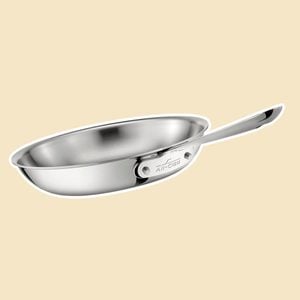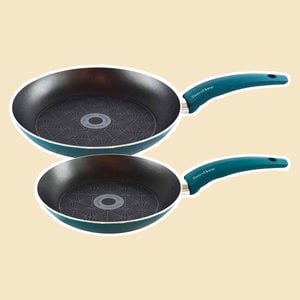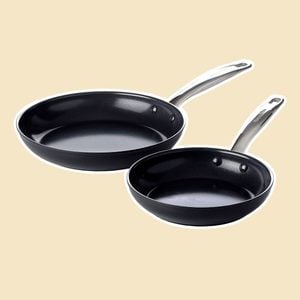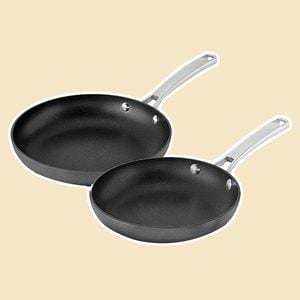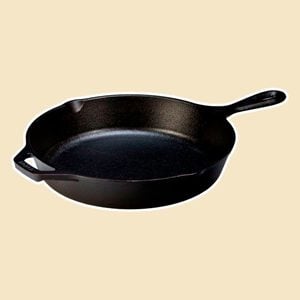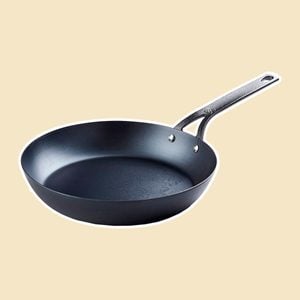The Ultimate Frying Pan Guide
Updated: May 02, 2024
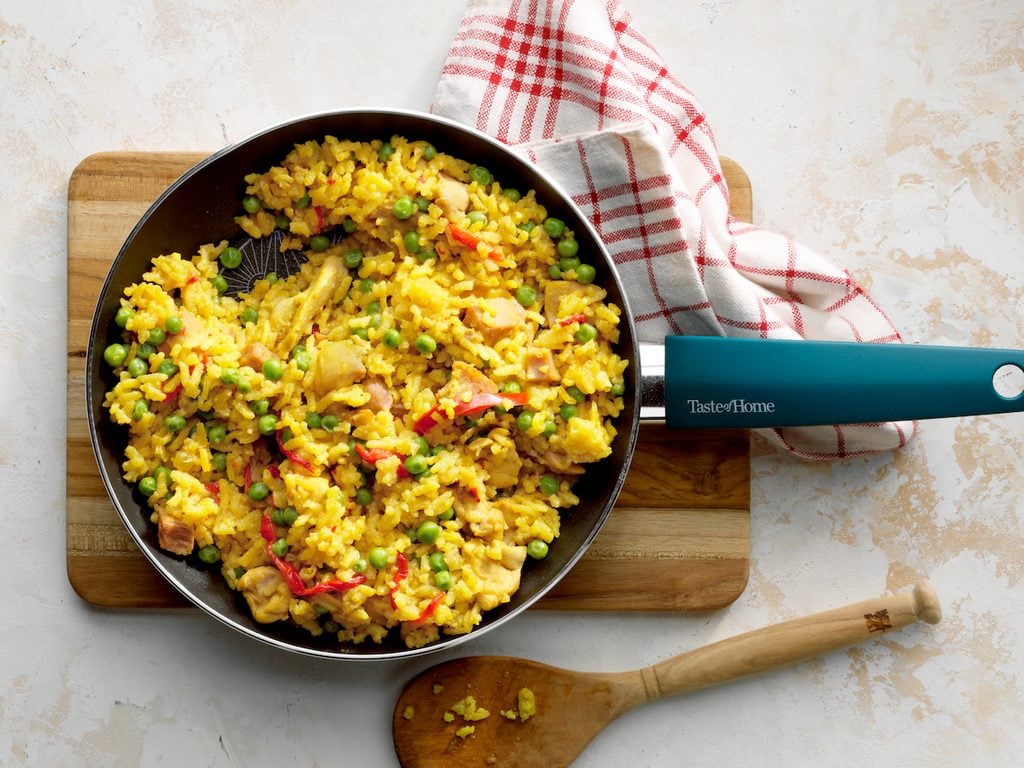
From cast-iron skillets to nonstick frying pans, this frying pan guide will help you pick the best pan to suit your needs.
Our editors and experts handpick every product we feature. We may earn a commission from your purchases.
Having a good frying pan in your cookware arsenal is a must. These pans can handle almost every cooking task you throw at them, from cooking eggs to searing, sauteing, braising, pan-frying, and more. With this versatility, you can cook anything from a fried egg to a full-blown chicken paella.
The number of choices you have when choosing a frying pan can be a little overwhelming, though. Frying pans come in a variety of sizes and materials, and it’s hard to know which frying pan is best to suit your needs. We take a look at the pros and cons of each type of pan in this complete frying pan guide.
On This Page
What Is a Frying Pan?
And is it different from a skillet? The terms “skillet” and “frying pan” are often used interchangeably because they’re basically the same thing: a flat-bottomed pan with a long handle and wide, sloped sides that flare out at an angle. This pan is an all-in-one kitchen workhorse that’s perfect for searing meat, sauteing vegetables, building pan sauces, pan-frying food and braising.
If we want to get picky with the terminology, a skillet is slightly deeper than a frying pan, and it generally refers to a pan made from cast iron. Frying pans, on the other hand, usually refer to pans made from nonstick material, but they can also be made with stainless steel, ceramic, aluminum and more.
(In case you were wondering, a frying pan is also different from a saute pan, which has tall, straight sides and always comes with a lid.)
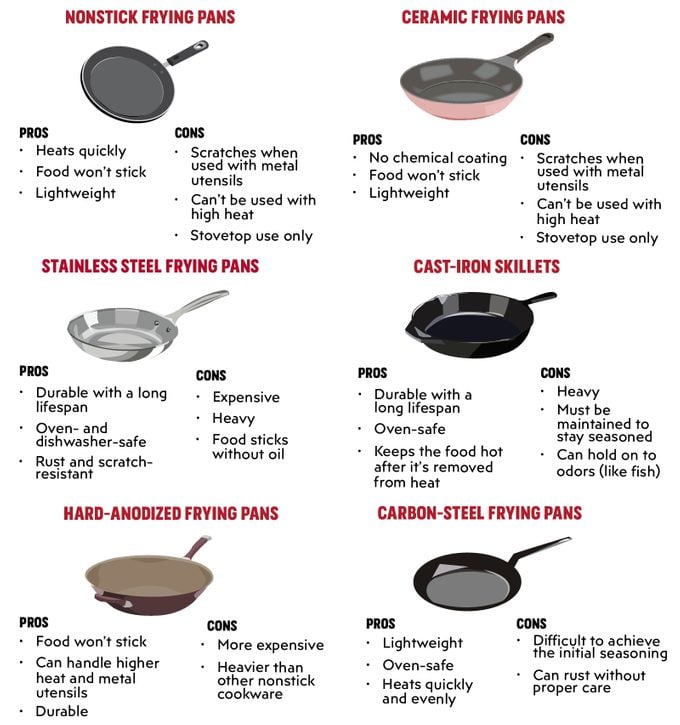
How Do I Choose the Best Frying Pan?
Before spending your money on a new pan, you’ll want to ask yourself a few questions. Do you plan to use the pan on the stovetop only, or do you want to use it in the oven, too? Will you use it for a variety of cooking tasks, or are you just trying to cook eggs? Is a lightweight pan important to you? Does it need to be large enough to cook dinner for four? These answers will help drive you to the best pan to fit your needs.
Review our tips for choosing the best skillet and consider each type of frying pan’s pros and cons.
Nonstick frying pans
These pans are usually made with aluminum and contain a PTFE or Teflon coating that keeps the food from sticking to their surface. They’re designed to cook items like eggs, pancakes, crepes or fish. You can use them to cook other items, but they aren’t meant for use with high heat so they’ll never create a hard sear.
Pros
- Heats quickly
- Food won’t stick
- Lightweight
Cons
- Scratches when used with metal utensils
- Can’t be used with high heat
- Stovetop use only
Ceramic frying pans
These “green” nonstick pans are coated with a silica-based gel made from sand. Ceramic cookware is just as nonstick as coated pans, but without the use of any chemicals.
Pros
- No chemical coating
- Food won’t stick
- Lightweight
Cons
- Scratches when used with metal utensils
- Can’t be used with high heat
- Stovetop use only
Hard-anodized frying pans
Our last nonstick option is more durable than the first two. These pans are manufactured with a process than makes them stronger than regular aluminum. That means you can use them at higher heat like a stainless-steel pan and they’re more durable, so go ahead and use them with metal utensils.
Pros
- Food won’t stick
- Can handle higher heat and metal utensils
- Durable
Cons
- More expensive than other nonstick cookware
- Heavier than other nonstick cookware
Stainless steel frying pans
Stainless steel alone isn’t a good conductor of heat, which is why we recommend using tri-ply pans that fuse together multiple layers of metal. That process makes these pans heavier than single-layered pans, but they’re still lighter than cast iron. Stainless steel pans are great for searing and braising meat, pan-frying or sauteing, making pan sauces or cooking foods in the oven. Check out our guide for cooking with stainless steel.
Pros
- Durable with a long lifespan
- Oven- and dishwasher-safe
- Rust and scratch-resistant
Cons
- Expensive (especially tri-ply pans)
- Heavy
- Food sticks without oil
Cast-iron skillets
If we had to pick one piece of cookware, it would probably be our cast-iron skillet. These heavy-duty pans are extremely versatile. A properly-seasoned cast-iron pan can cook eggs, pan-fry chicken or steak and create a variety of one-pot meals (not to mention they can be used for dessert and to bake bread).
Pros
- Durable with a long lifespan
- Oven-safe
- Keeps the food hot after it’s removed from the heat source
Cons
- Heavy
- Must be maintained to stay seasoned
- Can hold on to odors (like fish)
Carbon-steel frying pans
Carbon steel is similar to cast iron, but it’s much lighter because it’s made with thinner material. These pans heat up quickly, but they also lose heat just as quickly. When properly seasoned, a carbon-steel skillet can be just as nonstick as a coated pan.
Pros
- Lightweight
- Oven-safe
- Heats quickly and evenly
Cons
- Difficult to achieve the initial seasoning
- Can rust without proper care
What Is the Best Frying Pan for Everyday Use?
If you’re mainly cooking breakfast, we recommend buying a nonstick frying pan for everyday use. These pans are also great if you’re on a low-fat diet, as you can use them without cooking oil or butter. A more versatile frying pan is a cast-iron skillet, but it’s too heavy for some people’s liking. If that’s the case, you may prefer a stainless-steel frying pan.
What Size Frying Pan Should I Buy?
A 12-inch frying pan is large enough to handle most cooking tasks. You can create skillet meals for four in one of these pans, and it also has enough space if you’re using it to pan-fry foods. We generally recommend a 10-inch nonstick skillet for egg cookery, although you may prefer a smaller, 8-inch frying pan if you usually cook for one or two.
Is a Nonstick Frying Pan Better?
A nonstick frying pan is definitely better at certain tasks. They excel at cooking without additional cooking oil and are perfect for delicate foods like eggs or fish. That said, their nonstick surface prevents them from getting a hard sear on foods. To achieve a golden-brown, caramelized crust on something like a steak or pork chop, you’ll need to use a pan without nonstick coating.
How Long Does a Frying Pan Last?
A high-quality, tri-ply stainless steel frying pan is definitely expensive, but it will practically last forever with proper care. Just be sure to keep it out of the dishwasher and wait until the pan completely cools before washing it to keep it from warping.
Nonstick pans, on the other hand, have a definite shelf life. In general, a nonstick pan should last about five years. If you notice any scratches in the pan’s coating, it’s time to toss it out. You don’t want the coating flaking off into your food.
Before you throw away the pan, see if you can fix it first. The handles can often be reattached if they’re loose, and nonstick surfaces can sometimes be fixed. But, in general, it’s time to replace your frying pan if it’s warped, has a surface that’s badly scratched or the handles are falling off.
The Best Frying Pans of 2022
- Best frying pan: All-Clad Stainless Steel Tri-Ply Bonded Fry Pan
- Best nonstick frying pan: Taste of Home Nonstick Aluminum Skillets
- Best ceramic-coated frying pan: GreenPan Ceramic Nonstick Frying Pans
- Best hard-anodized frying pan: Calphalon Nonstick Hard-Anodized Aluminum Fry Pan
- Best cast-iron skillet: Lodge Cast-Iron Skillet
- Best carbon-steel frying pan: BK Cookware Black Carbon Steel Skillet
There are several things to consider before buying a new frying pan: size, weight, material and whether it contains a nonstick finish. We recommend buying a stainless-steel skillet if you’re only going to buy one frying pan. The All-Clad 12-inch Stainless Steel Tri-Ply Bonded Fry Pan is an all-around kitchen workhorse. It works on the stovetop and in the oven, it heats up quickly and retains heat well, but it also comes with a hefty price tag. For a more economical choice, we also like the Tramontina Gourmet 12-inch Stainless Steel Tri-Ply Clad Fry Pan.
Nonstick frying pans are great for eggs, crepes and pancakes, and our culinary staff has specially developed a 2-piece non-stick aluminum skillet that’ll suit all your culinary needs. The 9.5-inch pan is perfect for single breakfast orders while the 11-inch pan works if you’re cooking for a crowd.
If you prefer a ceramic-coated pan, look to this set from GreenPan. Its coating is reinforced to avoid scratching when using metal utensils. Check out our guide for buying a nonstick pan to learn more about the different types of nonstick coatings.
This Calphalon nonstick hard-anodized aluminum skillet is available in 8-, 10- and 12-inches, covering all your bases. Use it on the stovetop for skillet meals or pop it in the oven to bake. It can handle temps up to 450 degrees.
If cast-iron is more your style, you can’t go wrong with a Lodge Cast-Iron Skillet. It’s pre-seasoned, so you’ll be ready to cook as soon as it arrives. Learn how to make the most of your skillet with our complete guide to cast iron cooking.
Finally, this carbon-steel pan from BK Cookware is a Test Kitchen favorite. Its black carbon steel construction is extremely durable and is designed to develop a nonstick seasoning over time.
Skillet Recipes
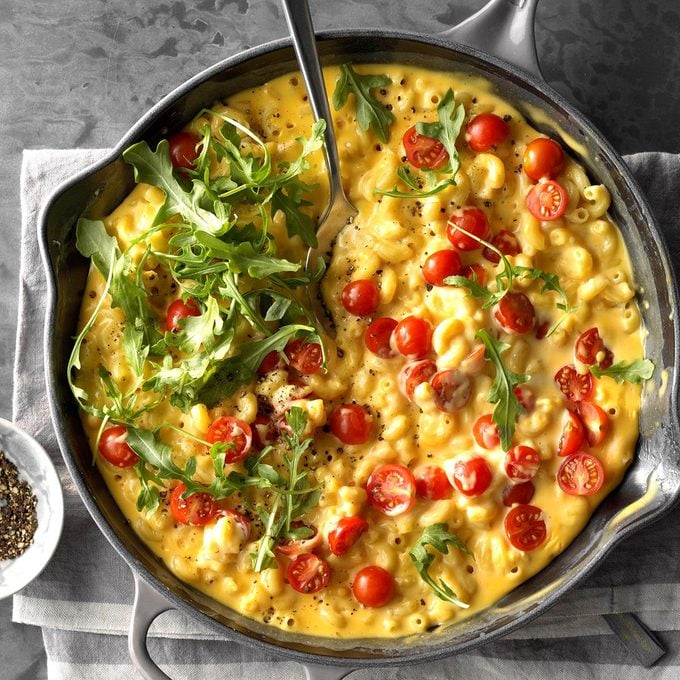
We keep referring to the skillet as the kitchen workhorse for a good reason. You can use it to make so many different meals, from breakfast to dessert.
For starters, skillets are great for cooking meat. Sear a thick steak, pork chop, pork tenderloin or whole chicken on the stovetop. Once it has a beautifully crisp exterior and golden brown color, transfer it to the oven if it needs to finish cooking. You can also use it exclusively on the stovetop to cook quicker-cooking meats like chicken cutlets or meatballs. Either way, be sure to use all those pan drippings to create a delicious pan sauce.
They’re also ideal for one-pan meals. Give it a try the next time you make pasta dishes like mac and cheese or rice dishes like Creole skillet dinner. Use it to stir-fry meat and vegetables like beef teriyaki, or make a breakfast hash with eggs and bring the skillet to the table as the serving dish. You can also finish your sauteed creation with mashed potatoes to make shepherd’s pie, or top it off with puff pastry to create an easy pot pie.
Don’t be afraid to think outside the box, either. A skillet is a perfect vessel for making homemade pizza or side dishes like cornbread. You’ll be surprised at how many cakes, cobblers, brownies and cookies you can make in a skillet, too.
[content id=”486989″ title=”Our Best Skillet Recipes”]
Skillet Cooking Tips
There’s nothing more frustrating than food sticking to a pan. You could always turn to nonstick cookware, but you don’t have to. The easiest way to prevent food from sticking to a stainless-steel or cast-iron pan is to preheat the pan with a thin layer of cooking oil before adding the other ingredients. When the oil begins to shimmer, the pan is ready to use. If you’re not sure, add a drop of water to the pan. If it makes a loud hissing noise and splits into individual droplets, the pan is ready to go!
Skillet Cleaning, Care and Storage
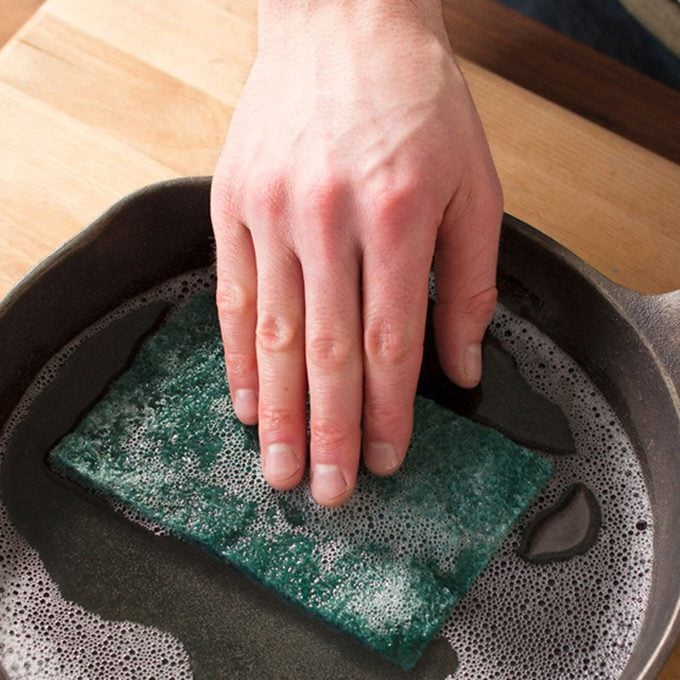
Before you use your skillet, read these tips to extend the life of your favorite frying pan.
How Do I Season a Frying pan?
Seasoning a stainless-steel or nonstick frying pan isn’t strictly necessary, but you may want to anyway. This process seals in the pores on the surface of the pan, creating a nonstick surface and extending the lifespan of the pan. Start by washing the pan with warm, soapy water. After drying it out, add a teaspoon of neutral cooking oil to the pan and heat it over medium heat for about a minute. Remove the pan from the heat and let it cool before removing the excess oil with a paper towel.
Psst! The seasoning process is different for different types of materials. Learn how to season a carbon-steel pan or a cast-iron skillet.
Are Frying Pans Dishwasher Safe?
In general, we recommend avoiding the dishwasher when it comes to pots, pans and cooking knives. The high-heat rinse cycle and harsh chemicals used in a dishwasher can damage the finish on your cookware, and it can also loosen the fittings that affix the handles to the pan. If you must use the dishwasher, check with the manufacturer first to make sure your pan is actually dishwasher-safe.
How to Clean a Frying Pan
The best way to clean a frying pan is by hand. Be sure to wait until the pan is completely cooled, or you can risk warping the pan or chipping any enameled or nonstick coating. If the pan has any burnt-on bits, soak the cooled pan in the sink using warm, soapy water. Really stubborn messes can be cleaned by simmering 1/4 cup of baking soda in a few inches of water for about 10 minutes. When the baking soda-water mixture cools, wash your pan like normal with soap and warm water.

